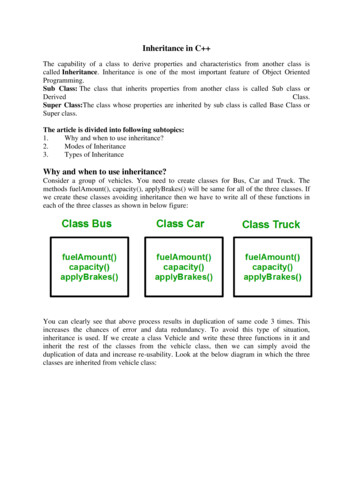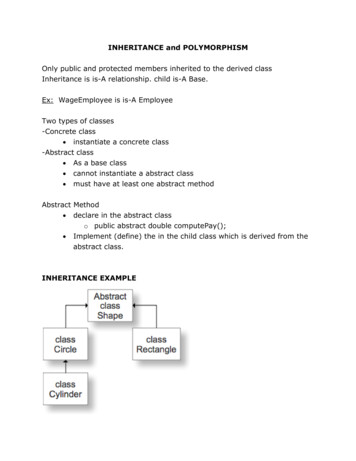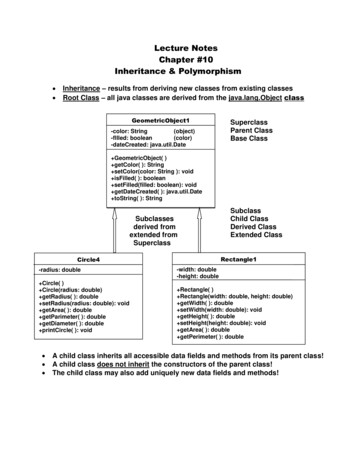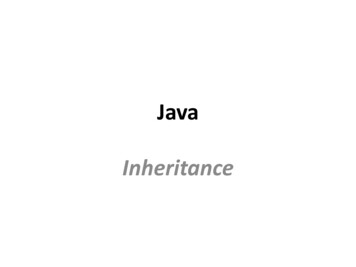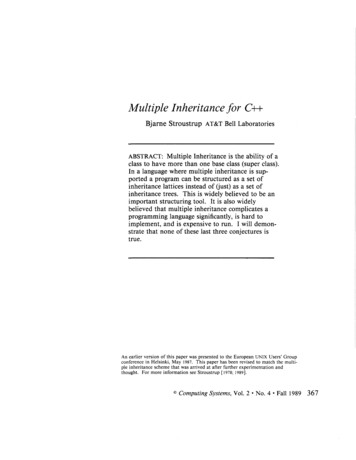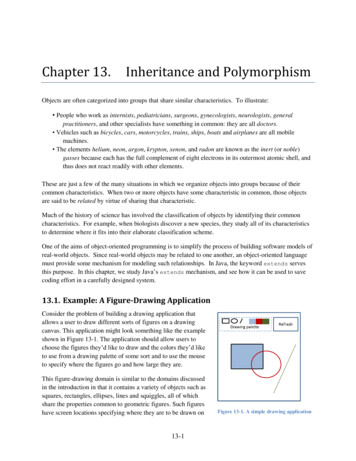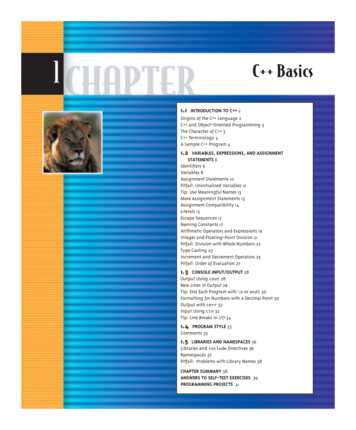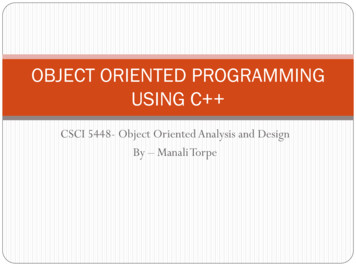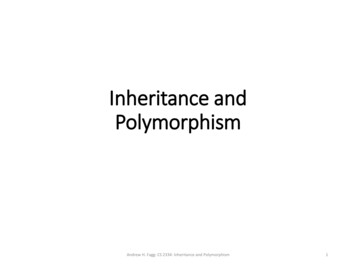
Transcription
Inheritance andPolymorphismAndrew H. Fagg: CS 2334: Inheritance and Polymorphism1
Notes Lab 4: Career fair overlaps sessions 2 (012) and 3 (013),so they will be short handed Anyone may attend any lab session this week Universal lab deadline: 7pm on Saturday (thisweek only) Project 1 is due in a little more than a weekAndrew H. Fagg: CS 2334: Inheritance and Polymorphism2
Relationships Between ClassesSo far: we have looked at class aggregation Class A has-a instance of class B This allows A to make use of what hasalready been done in class BAndrew H. Fagg: CS 2334: Inheritance and Polymorphism3
Sharing Data Between ClassesAggregation (Has-A) is one way to share databetween classes Can only use public parts of the class Is this a limitation or an advantage?Andrew H. Fagg: CS 2334: Inheritance and Polymorphism4
Sharing Data Between ClassesAnother way to share data is inheritanceAndrew H. Fagg: CS 2334: Inheritance and Polymorphism5
Sharing Data Between ClassesAnother way to share data is inheritance New class keyword: extends Defines the inheritance relationship UML: Arrow with open head Class A extends class B: Inherits everything from class B AND allows us toadd to itAndrew H. Fagg: CS 2334: Inheritance and Polymorphism6
Sharing Data Between ClassesAnother way to share data is inheritance New method/data visibility keyword:protected This data item/method is visible both inside theclass and to classes that extend this class Also visible to other classes in the same package # in UML (as opposed to or -)Andrew H. Fagg: CS 2334: Inheritance and Polymorphism7
Example: Online Ordering for AmazonConsider the following product types andcreate a hierarchy: Product Downloadable software Software with media BookWhat is the UML?Andrew H. Fagg: CS 2334: Inheritance and Polymorphism8
Where Do These Properties Belong inthe Hierarchy? Price URL for downloading software Name of item Author ISBN Delivery method Shipping costsAndrew H. Fagg: CS 2334: Inheritance and Polymorphism9
Terminology Subclass can be called: Child class Superclass can also be called: Parent class Base classAndrew H. Fagg: CS 2334: Inheritance and Polymorphism10
Terminology Subclasses get direct access to all of thepublic and protected data and methods fromsuperclass May have to implement methods again if weneed more specific behaviorAndrew H. Fagg: CS 2334: Inheritance and Polymorphism11
Consider equals()Have you noticed that equals() works in aclass, even if you didn’t put it there?Andrew H. Fagg: CS 2334: Inheritance and Polymorphism12
Consider equals()How does the program find an equals methodin the Equalizer class?Andrew H. Fagg: CS 2334: Inheritance and Polymorphism13
Consider equals()How does the program find an equals methodin the Equalizer class? It is defined in the Object class:public boolean equals(Object o)Andrew H. Fagg: CS 2334: Inheritance and Polymorphism14
Consider equals()Exercise: Demonstrate that this method is not workingproperly Why? Fix it and demonstrate it Draw UML of Equalizer, both before and afterAndrew H. Fagg: CS 2334: Inheritance and Polymorphism15
How about toString() What does toString() do? Or hashCode()?Andrew H. Fagg: CS 2334: Inheritance and Polymorphism16
Modeling Relationships The relationship represented by aggregation(with the diamond in UML) is “has-a” The relationship represented by inheritance(with the open headed arrow in UML) is “is-a” More specialized classes are lower in thehierarchyAndrew H. Fagg: CS 2334: Inheritance and Polymorphism17
Modeling RelationshipsExercises: Example: Shape, Circle, Square, Ellipse,Rectangle, Quadrilateral Example: Student, Name, Address, City, State,Country, First Name, Last Name, MiddleNameAndrew H. Fagg: CS 2334: Inheritance and Polymorphism18
Inheritance Can be Bad if DoneIncorrectly Inheritance is widely used in Java And all OOP languages Works fabulously in GUI components, andcollections Inheritance breaks encapsulation if we usethe protected keyword Aggregation/composition do not breakencapsulationAndrew H. Fagg: CS 2334: Inheritance and Polymorphism19
Private or Protected Data?Choosing private or protected can be a toughcall If everything is private: Inheritance doesn’t provide the subclass itselfwith anything it can’t get through composition However: the “user” of a class does get to see aconsistent interface between the super and childclassesAndrew H. Fagg: CS 2334: Inheritance and Polymorphism20
Private or Protected Data?Choosing private or protected can be a toughcall If everything is protected Classes become closely coupled Changes in one are likely to causes changes in theother Bad for maintenance ( ) These effects can be mitigated somewhatthrough the use of multiple packagesAndrew H. Fagg: CS 2334: Inheritance and Polymorphism21
Private or Protected Data?Choosing private or protected can be a toughcall My take: stick with privateAndrew H. Fagg: CS 2334: Inheritance and Polymorphism22
Administrivia Lab 4 Project 1Andrew H. Fagg: CS 2334: Inheritance and Polymorphism23
Specification to Implementation There is a direct translation from UML to theskeleton of the class Class/instance variables Method prototypes Then, look to our specification document andany method-level documentation that weprovide for a discussion about what themethods doAndrew H. Fagg: CS 2334: Inheritance and Polymorphism24
Specification to Implementation For the projects, and even the labs: get usedto shifting your focus between differentlevels of the problem In general, when you are working on oneclass, you have to put the rest of theimplementation out of your head Worry about what this class is supposed toprovide as an interface and how this should beimplementedAndrew H. Fagg: CS 2334: Inheritance and Polymorphism25
A/B exampleAndrew H. Fagg: CS 2334: Inheritance and Polymorphism26
Implementing Inheritance: InstanceMethods and Variables super.methodName() to explicitly call publicor protected methods in the superclass For a given class, remember that there is exactlyone superclass because Java does not allowmultiple inheritance super.instanceVariableName to refer topublic or protected instance variables fromthe superclassAndrew H. Fagg: CS 2334: Inheritance and Polymorphism27
Implementing Inheritance:Constructor Constructors are not inherited But: can use super() to call the superclassconstructor If used, it must be first statement in subclassconstructors Can call any of the constructors associated withthe superclass Most constructors call other constructors Andrew H. Fagg: CS 2334: Inheritance and Polymorphism28
CompilerIf you don’t use super(), compiler addsimplicitly for you Why?Andrew H. Fagg: CS 2334: Inheritance and Polymorphism29
Inheritance exampleAndrew H. Fagg: CS 2334: Inheritance and Polymorphism30
PolymorphismA variable of a super type can really be aninstantiation of the sub typeProduce pr new Apple();This is called “Upcasting”// We get Apple.computePrice()//from this call.pr.computePrice();Andrew H. Fagg: CS 2334: Inheritance and Polymorphism31
Polymorphism: Methods Calling methods: Java Virtual Machine will selectmethod based on object type at run time (not thetype of the reference) Search order: constructed class if available, then parent,then grandparent, etc.Produce pr new Apple();pr.toString();// Calls Apple.toString() Exercise: show example with Produce hierarchyAndrew H. Fagg: CS 2334: Inheritance and Polymorphism32
Polymorphism: Variables References to instance/class variables aredecided at compile time When an instance/class variable is accessed,the compiler starts looking for the variablestarting with the class of the reference type If not found, then the parent class is checked If not found, then the grandparent class ischecked Andrew H. Fagg: CS 2334: Inheritance and Polymorphism33
A/B example revisitAndrew H. Fagg: CS 2334: Inheritance and Polymorphism34
Administriva Project 1 due Wednesday Code reviews: get them done as early as possible Lab 5 coming soon Those who attend lecture will be given priorityduring Friday office hoursAndrew H. Fagg: CS 2334: Inheritance and Polymorphism35
Overriding MethodsWhen a subclass implements a method that isidentical to one in the superclass, it overridesthe superclass method Superclass method must be public orprotected Same name Same parameters Return values: new method must return asubclass of the original method’s return type Static methods cannot be overriddenAndrew H. Fagg: CS 2334: Inheritance and Polymorphism36
A/B example Dynamic bindingAndrew H. Fagg: CS 2334: Inheritance and Polymorphism37
Inheritance ExampleAndrew H. Fagg: CS 2334: Inheritance and Polymorphism38
Recall: UpcastingA variable of a super type can really be aninstantiation of the sub typeProduce pr new Apple();This is called “Upcasting”// We get Apple.computePrice()//from this call.pr.computePrice();Andrew H. Fagg: CS 2334: Inheritance and Polymorphism39
UpcastingUpcasting works by default because everyApple is guaranteed to do everything that aProduce object does This is true for any inheritance relationship:the child class is guaranteed to do everythingthat the parent class providesAndrew H. Fagg: CS 2334: Inheritance and Polymorphism40
Down-CastingThe other way can be made to work, but weneed to be explicit:Apple a pr;// Compiler disallowsApple a (Apple) pr;// Allowed Forces java to treat the object as if it is thesubclass Lets you access subclass methods If you improperly cast an object, you will receiveExceptions when you try to access the objectAndrew H. Fagg: CS 2334: Inheritance and Polymorphism41
Casting and instanceofinstanceof will tell you whether an instance isa member of a class:if (pr instanceof Apple) {Apple a (Apple) pr;// Use a .}Andrew H. Fagg: CS 2334: Inheritance and Polymorphism42
ArrayList exampleExercise: make an ArrayList of Produce andFruit What can go in each? Printing out the listsAndrew H. Fagg: CS 2334: Inheritance and Polymorphism43
Immutable Classes and Inheritance It is possible to make a class so that it cannotbe extendedpublic final class ClassName This must be done with all immutable classes Why? Again, if unsure, make class final Can always remove it later Once you let people extend a class, you can’tmake changes or risk breaking their codeAndrew H. Fagg: CS 2334: Inheritance and Polymorphism44
Another way to share data is inheritance New method/data visibility keyword: protected This data item/method is visible both inside the class and to classes that extend this class Also visible to other classes in the same package # in UML (as opposed to or -) Andrew H. Fagg: CS 2334: Inheritance and Polymorphism 7


